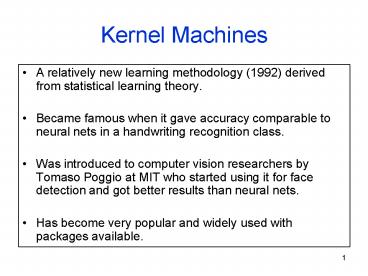Kernel Machines - PowerPoint PPT Presentation
Title:
Kernel Machines
Description:
Title: Introduction to Artificial Intelligence Author: Linda Shapiro Last modified by: Linda Shapiro Created Date: 9/19/2005 8:30:33 PM Document presentation format – PowerPoint PPT presentation
Number of Views:116
Avg rating:3.0/5.0
Title: Kernel Machines
1
Kernel Machines
- A relatively new learning methodology (1992)
derived from statistical learning theory. - Became famous when it gave accuracy comparable to
neural nets in a handwriting recognition class. - Was introduced to computer vision researchers by
Tomaso Poggio at MIT who started using it for
face detection and got better results than neural
nets. - Has become very popular and widely used with
packages available.
2
Support Vector Machines (SVM)
- Support vector machines are learning algorithms
- that try to find a hyperplane that
separates - the different classes of data the most.
- They are a specific kind of kernel machines based
on - two key ideas
- maximum margin hyperplanes
- a kernel trick
3
Maximal Margin (2 class problem)
In 2D space, a hyperplane is a line. In 3D
space, it is a plane.
margin
hyperplane
Find the hyperplane with maximal margin for
all the points. This originates an optimization
problem which has a unique solution.
4
Support Vectors
- The weights ?i associated with data points are
zero, except for those points closest to the
separator. - The points with nonzero weights are called the
support vectors (because they hold up the
separating plane). - Because there are many fewer support vectors than
total data points, the number of parameters
defining the optimal separator is small.
5
(No Transcript)
6
The Kernel Trick
The SVM algorithm implicitly maps the
original data to a feature space of possibly
infinite dimension in which data (which is not
separable in the original space) becomes
separable in the feature space.
Feature space Rn
Original space Rk
1
1
1
0
0
0
1
0
0
1
0
0
1
Kernel trick
0
0
0
1
1
7
Example from Text
True decision boundary is x12 x22 lt 1 .
- Mapping the data to the 3D space defined by
- f1 x12, f2 x22, f3 21/2 x1
x2 - makes it linearly separable by a plane in 3D.
- For this problem F(xi) F(xj) is just (xi
xj)2, - which is called a kernel function.
8
Kernel Functions
- The kernel function is designed by the developer
of the SVM. - It is applied to pairs of input data to evaluate
dot products in some corresponding feature space. - Kernels can be all sorts of functions including
polynomials and exponentials.
9
Kernel Function used in our 3D Computer Vision
Work
- k(A,B) exp(-?2AB/?2)
- A and B are shape descriptors (big vectors).
- ? is the angle between these vectors.
- ?2 is the width of the kernel.
10
Unsupervised Learning
- Find patterns in the data.
- Group the data into clusters.
- Many clustering algorithms.
- K means clustering
- EM clustering
- Graph-Theoretic Clustering
- Clustering by Graph Cuts
- etc
11
Clustering by K-means Algorithm
Form K-means clusters from a set of n-dimensional
feature vectors 1. Set ic (iteration count) to
1 2. Choose randomly a set of K means m1(1), ,
mK(1). 3. For each vector xi, compute
D(xi,mk(ic)), k1,K and assign xi to the
cluster Cj with nearest mean. 4. Increment ic
by 1, update the means to get m1(ic),,mK(ic). 5.
Repeat steps 3 and 4 until Ck(ic) Ck(ic1) for
all k.
12
K-Means Classifier(shown on RGB color data)
original data one RGB per pixel
color clusters
13
K-Means ? EMThe clusters are usually Gaussian
distributions.
- Boot Step
- Initialize K clusters C1, , CK
- Iteration Step
- Estimate the cluster of each datum
- Re-estimate the cluster parameters
(?j, ?j) and P(Cj) for each cluster j.
Expectation
Maximization
The resultant set of clusters is called a mixture
model if the distributions are Gaussian, its a
Gaussian mixture.
14
EM Algorithm Summary
- Boot Step
- Initialize K clusters C1, , CK
- Iteration Step
- Expectation Step
- Maximization Step
(?j, ?j) and p(Cj) for each cluster j.
15
EM Clustering using color and texture information
at each pixel(from Blobworld)
16
EM for Classification of Images in Terms of their
Color Regions
17
Sample Results
cheetah
18
Sample Results (Cont.)
grass
19
Sample Results (Cont.)
lion































